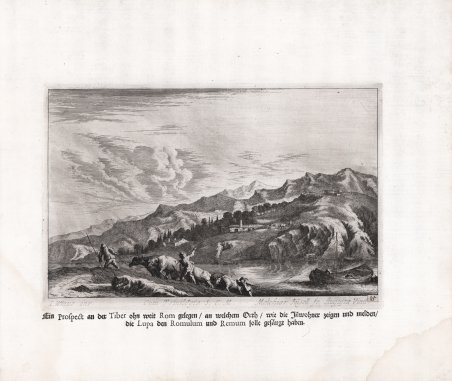Veduta panoramica di Orte e del Tevere, incisa da Melchior Küsel da un disegno di Johann Wilhelm Baur. Acquaforte, 1670 circa, firmata sulla lastra in basso a destra. Bella impressione su carta vergata coeva, ottimo stato di conservazione. L'opera fa parte delle suite di vedute paesaggistiche dell'Italia, eseguite da Johann Wilhelm Baur negli anni Trenta del Seicento e incise da Melchior Küsel (1636-1683). Baur nacque a Strasburgo nel 1607 e fu formato da Friedrich Brentel come disegnatore e pittore di miniature. Verso il 1630 si recò in Italia, vivendo prima a Napoli e poi a Roma sotto il patrocinio delle famiglie Colonna e Orsini. Nel 1637 tornò a nord, passando per Venezia, a Vienna, dove morì nel 1642. Durante questo soggiorno Baur realizzò centinaia di disegni, alcuni molto rifiniti e destinati a essere presentati ai suoi nobili committenti, altri a essere utilizzati per le stampe. L'incisore Melchior Küsel acquistò circa duecento disegni di Baur dopo la morte dell'artista, tra cui scene della vita, dei miracoli e della Passione di Gesù Cristo, mitologia classica, vedute dei porti, delle ville e dei giardini di Napoli, Roma e Venezia, il paesaggio intorno a Livorno, Ancona, Lucca, Firenze, il Friuli e la penisola istriana. Nel 1670 Küsel pubblicò ad Augusta l'Iconographia, dedicata all'imperatore Leopoldo e comprendente 148 incisioni su disegno di Baur, di cui sessantotto erano vedute italiane e il resto soggetti religiosi o storici. Nuove edizioni dell'Iconographia apparvero sotto l'imprint di Küsel nel 1671, 1672 e 1682, e sotto quella del genero Johann Ulrich Kraus nel 1686 e nel 1702. Bibliografia F.W.H. Hollstein, German etchings, engravings & woodcuts 1400–1700, XX (Amsterdam 1977), p.111, nos.476–490. Panoramic view of Orte and the Tiber, engraved by Melchior Küsel after Johann Wilhelm Baur. Etching, circa 1670, signed on plate at lower right. A fine impression on contemporary laid paper, very good condition. The work is part of the suites of landscape views of Italy, executed by Johann Wilhelm Baur in the 1630s, and engraved a generation later by Melchior Küsel (1636–1683). Baur was born at Strasbourg in 1607 and was trained by Friedrich Brentel as a draughtsman and miniature painter. About 1630, he went to Italy, living first at Naples, then in Rome under the patronage of the Colonna and Orsini families. In 1637, he returned north via Venice to Vienna, where he died in 1642. Baur made hundreds of drawings during this sojourn, some highly finished and intended for presentation to his noble patrons, others to be used for prints. The engraver Melchior Küsel acquired about two hundred of Baur’s drawings after the death of the artist, including scenes of the life, miracles and Passion of Jesus Christ, classical mythology, views of the harbours, villas, and gardens of Naples, Rome, and Venice, the landscape around Livorno, Ancona, Lucca, Florence, and of the Friuli and Istrian peninsula. In 1670 Küsel published at Augsburg the Iconographia, dedicated to the emperor Leopold, and comprising 148 engravings after Baur’s designs of which sixty-eight were Italian views and the rest religious or historical subjects. New editions of the Iconographia appeared under Küsel’s imprint in 1671, 1672, and 1682, and under the imprint of his son-in-law Johann Ulrich Kraus in 1686 and 1702. Bibliografia F.W.H. Hollstein, German etchings, engravings & woodcuts 1400–1700, XX (Amsterdam 1977), p.111, nos.476–490. Cfr.

Descubre cómo utilizar
Descubre cómo utilizar

